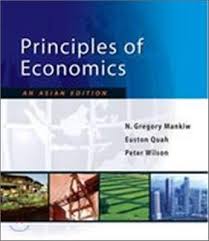Description
Principles of Economics An Asian Edition 1st Edition by N. Gregory Mankiw – Test bank
Chapter 5: MC-Elasticity and Its Application
MULTIPLE CHOICE
1.In general, elasticity is a measure of
|
a. |
the extent to which advances in technology are adopted by producers. |
|
b. |
the extent to which a market is competitive. |
|
c. |
how fast the price of a good responds to a shift of the supply curve or demand curve. |
|
d. |
how much buyers and sellers respond to changes in market conditions. |
ANS: D
PTS: 1 DIF: 1 REF: 5-0 TOP: Elasticity
MSC: Definitional
2.When studying how some event or policy affects a market, elasticity provides information on the
|
a. |
direction of the effect on the market. |
|
b. |
magnitude of the effect on the market. |
|
c. |
speed of adjustment of the market in response to the event or policy. |
|
d. |
number of market participants who are directly affected by the event or policy. |
ANS: B
PTS: 1 DIF: 2 REF: 5-0 TOP: Elasticity
MSC: Interpretive
3.How does the concept of elasticity allow us to improve upon our understanding of supply and demand?
|
a. |
Elasticity allows us to analyze supply and demand with greater precision than would be the case in the absence of the elasticity concept. |
|
b. |
Elasticity provides us with a better rationale for statements such as “an increase in x will lead to a decrease in y” than we would have in the absence of the elasticity concept. |
|
c. |
Without elasticity, we would not be able to address the direction in which price is likely to move in response to a surplus or a shortage. |
|
d. |
Without elasticity, it is very difficult to assess the degree of competition within a market. |
ANS: A
PTS: 1 DIF: 2 REF: 5-0 TOP: Elasticity
MSC: Interpretive
4.Elasticity improves our understanding of supply and demand by adding
|
a. |
measures of equity. |
|
b. |
measures of efficiency. |
|
c. |
a quantitative element to our analysis. |
|
d. |
a qualitative element to our analysis. |
ANS: C
PTS: 1 DIF: 2 REF: 5-0 TOP: Elasticity
MSC: Interpretive
5.The price elasticity of demand measures how much
|
a. |
the quantity demanded responds to a change in price. |
|
b. |
the quantity demanded responds to a change in income. |
|
c. |
price responds to a change in demand. |
|
d. |
demand responds to a change in supply. |
ANS: A
PTS: 1 DIF: 1 REF: 5-1 TOP: Price elasticity of demand
MSC: Definitional
6.The price elasticity of demand measures
|
a. |
buyers’ responsiveness to a change in the price of a good. |
|
b. |
the extent to which demand increases as additional buyers enter the market. |
|
c. |
how much more of a good consumers will demand when incomes rise. |
|
d. |
the movement along a supply curve when there is a change in demand. |
ANS: A
PTS: 1 DIF: 1 REF: 5-1 TOP: Price elasticity of demand
MSC: Definitional
7.Demand is said to be elastic if
|
a. |
the price of the good responds substantially to changes in demand. |
|
b. |
demand shifts substantially when income or the expected future price of the good changes. |
|
c. |
buyers do not respond much to changes in the price of the good. |
|
d. |
buyers respond substantially to changes in the price of the good. |
ANS: D
PTS: 1 DIF: 2 REF: 5-1 TOP: Elastic demand
MSC: Definitional

Reviews
There are no reviews yet.